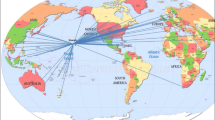Abstract
The participation of racial and ethnic minorities and underserved populations in clinical trials is a critical link between scientific innovation and improvements in health care delivery and health outcomes. However, these population groups continue to be underrepresented in research. We describe the development of the Cancer Disparities Research Network (CDRN) to improve minority and underserved populations’ participation in biobanking research. Between February and October 2011, we conducted a regional assessment to identify challenges and opportunities for cancer trials and biobanking research across the CDRN. Representatives from ten CDRN biorepository facilities completed an online survey assessing their facilities’ minority biospecimen collection, biobanking practices, and education/outreach initiatives. Representatives of eight facilities also participated in stakeholder interviews. The majority (70 %) of facilities reported that specimens were available for research, although only one tenth of these specimens were from non-White patients. Most facilities collected a patient’s age, gender, race, medical history, and ethnicity with samples; however, less than half also collected family health history, education level, household income, or primary language spoken. In addition, few institutions collected Asian or Hispanic subgroup information. Only a few reported biospecimen collection outreach programs specifically targeting minority and underserved populations. Biospecimen directors and administrators indicated that funding, biospecimen sharing procedures, and standardization barriers limited their facilities from collaborating in biospecimen collection programs, despite their great interest. These findings suggest that the CDRN can provide opportunities for collaboration, resource sharing, and fostering of research ideas to address cancer disparities in biospecimen research.

Similar content being viewed by others
References
Watson RW, Kay EW, Smith D (2010) Integrating biobanks: addressing the practical and ethical issues to deliver a valuable tool for cancer research. Nat Rev Cancer 10(9):646–651
The Unequal Burden of Cancer (1999) An Assessment of NIH Research and Programs for Ethnic Minorities and the Medically Underserved, ed. M.A. Haynes and B.D. Smedley: The National Academies Press
Colon-Otero G et al (2008) Disparities in participation in cancer clinical trials in the United States: a symptom of a healthcare system in crisis. Cancer 112(3):447–454
Ford JG et al (2008) Barriers to recruiting underrepresented populations to cancer clinical trials: a systematic review. Cancer 112(2):228–242
Ford JG et al (2005) Knowledge and access to information on recruitment of underrepresented populations to cancer clinical trials. Evid Rep Technol Assess (Summ) 122:1–11
Sateren WB et al (2002) How sociodemographics, presence of oncology specialists, and hospital cancer programs affect accrual to cancer treatment trials. J Clin Oncol 20(8):2109–2117
Byrne, MM. et al. (2013) Participation in Cancer Clinical Trials: Why Are Patients Not Participating? Med Decis Making
Rivers D et al (2013) A systematic review of the factors influencing African Americans’ participation in cancer clinical trials. Contemp Clin Trials 35(2):13–32
Fleisher L et al (1998) Building effective partnerships: a national evaluation of the Cancer Information Service outreach program. Part 2 J Health Commun 3(Suppl1):21–35
Myers RE et al (2006) Increasing access to clinical and educational studies. Cancer 107(8 Suppl):1962–1970
Fleisher L et al (2007) The NCI’s Cancer Information Service’s Research Continuum Framework: integrating research into cancer education practice (1999–2004). J Cancer Educ 22(1 Suppl):S41–S48
Simon MA, R.D., Willis C, Hajjar N, Murphy K, Dong X (2013) Leveraging a community-based participatory research approach to explore research perceptions among suburban poor and underserved populations. Journal of Community Engagement and Scholarship, In press
Samaras A, M K, Nonzee N, Endress R, Hajiar N, Bularzik R, Frankovich C, Dong XQ, Simon MA (2013) Community–campus partnership in action: lessons learned from the DuPage county patient navigation collaborative. Progress in Community Health Partnerships: Research, Education, and Action, In press
Dong XQ, L.Y., Chen R, Chang ES, Simon MA, Simon MA (2013) Evaluation of community health education workshops among Chinese older adults in Chicago: a community-based participatory research approach. Journal of Education Training and Studies, In press
Kaur JS, Petereit DG (2012) Personalized medicine: challenge and promise. J Cancer Educ 27(1):12–17
Compton C (2007) Getting to personalized cancer medicine: taking out the garbage. Cancer 110(8):1641–1643
Vaught JB, Henderson MK, Compton CC (2012) Biospecimens and biorepositories: from afterthought to science. Cancer Epidemiol Biomarkers Prev 21(2):253–255
Fiore S (2008) Interdisciplinarity as teamwork: how the science of teams can inform team science. Small Group Research 39(3):251–277
Cummings JN, Kiesler S (2005) Collaborative research across disciplinary and organizational boundaries. Soc Stud Sci 35(5):703–722
Robb JA et al (2013) A call to standardize preanalytic data elements for biospecimens. Arch Pathol Lab Med 137:1185–1190
Khleif SN, Doroshow JH, Hait WN (2010) AACR-FDA-NCI cancer biomarkers collaborative consensus report: advancing the use of biomarkers in cancer drug development. Clin Cancer Res 16(13):3299–3318
Wendler D et al (2006) Are racial and ethnic minorities less willing to participate in health research? PLoS Med 3(2):e19
Buetow KH (2009) An infrastructure for interconnecting research institutions. Drug Discov Today 14(11–12):605–610
Hewitt RE (2011) Biobanking: the foundation of personalized medicine. Curr Opin Oncol 23(1):112–119
Hill TG et al (2010) Evaluation of Cancer 101: an educational program for native settings. J Cancer Educ 25(3):329–336
Author information
Authors and Affiliations
Corresponding author
Additional information
This paper is dedicated in loving memory to Piotr Kulesza, a true inspirational leader in the pathology and clinical research field who was committed to advancing research and addressing cancer health disparities. His genuine enthusiasm and love for teaching and mentoring were contagious.
Rights and permissions
About this article
Cite this article
Simon, M.A., de la Riva, E.E., Bergan, R. et al. Improving Diversity in Cancer Research Trials: The Story of the Cancer Disparities Research Network. J Canc Educ 29, 366–374 (2014). https://doi.org/10.1007/s13187-014-0617-y
Published:
Issue Date:
DOI: https://doi.org/10.1007/s13187-014-0617-y




